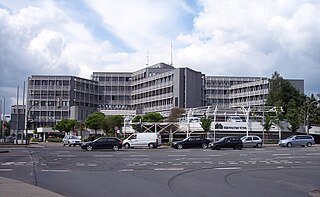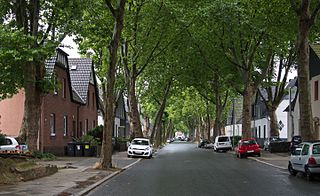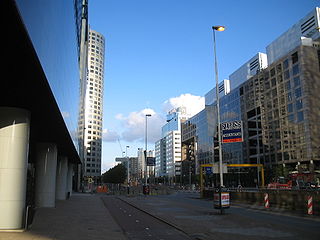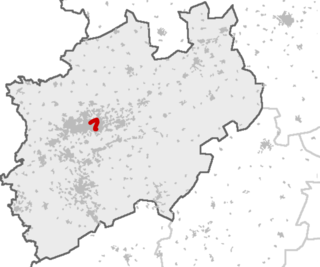
Bochum is a city in North Rhine-Westphalia. With a population of 372,348, it is the sixth largest city in one of the most populous German federal states of North Rhine-Westphalia, and the 16th largest city of Germany. On the Ruhr Heights (Ruhrhöhen) hill chain, between the rivers Ruhr to the south and Emscher to the north, it is the second largest city of Westphalia after Dortmund, and the fourth largest city of the Ruhr after Dortmund, Essen and Duisburg. It lies at the centre of the Ruhr, Germany's largest urban area, in the Rhine-Ruhr Metropolitan Region, and belongs to the region of Arnsberg. Bochum is the sixth largest and one of the southernmost cities in the Low German dialect area. There are nine institutions of higher education in the city, most notably the Ruhr University Bochum, one of the ten largest universities in Germany, and the Bochum University of Applied Sciences.

Gelsenkirchen is the 25th most populous city of Germany and the 11th most populous in the state of North Rhine-Westphalia with 262,528 (2016) inhabitants. On the Emscher River, it lies at the centre of the Ruhr, the largest urban area of Germany, of which it is the fifth largest city after Dortmund, Essen, Duisburg and Bochum. The Ruhr is located in the Rhine-Ruhr Metropolitan Region, the second biggest metropolitan region by GDP in the European Union. Gelsenkirchen is the fifth largest city of Westphalia after Dortmund, Bochum, Bielefeld and Münster, and it is one of the southernmost cities in the Low German dialect area. The city is home to the football club Schalke 04, which is named after Gelsenkirchen-Schalke. The club's current stadium Veltins-Arena, however, is located in Gelsenkirchen-Erle.

The Märkischer Kreis is a district (Kreis) in central North Rhine-Westphalia, Germany. Neighbouring districts are Unna, Soest, Hochsauerland, Olpe, Oberbergischer Kreis, Ennepe-Ruhr, and the city of Hagen.

Coesfeld is a Kreis (district) in the northwestern part of North Rhine-Westphalia, Germany, west of the city of Münster. Neighboring districts are Steinfurt, district-free Münster, Warendorf, district-free Hamm, Unna, Recklinghausen, Borken.
The Oberbergischer Kreis is a Kreis (district) in the state of North Rhine-Westphalia, Germany. Neighboring districts are Ennepe-Ruhr, Märkischer Kreis, Olpe, Altenkirchen, Rhein-Sieg, Rheinisch-Bergischer Kreis, and the urban districts Remscheid and Wuppertal.
The Rheinisch-Bergische Kreis is a Kreis (district) in the Cologne Bonn Region of North Rhine-Westphalia, Germany. Neighboring districts are Kreis Mettman, Oberbergischer Kreis and Rhein-Sieg, and the district-free cities Cologne, Leverkusen, Solingen and Remscheid.
Recklinghausen is a Kreis (district) in the centre of North Rhine-Westphalia, Germany. It is surrounded by the neighbouring districts of Borken, Coesfeld, Unna, Gelsenkirchen, Bottrop, and Wesel. The district administration is located in the city of the same name.

Witten is a city with almost 100,000 inhabitants in the Ennepe-Ruhr-Kreis (district) in North Rhine-Westphalia, Germany.

The Eichsfeld is a historical region in the southeast of the state of Lower Saxony and northwest of the state of Thuringia in the south of the Harz mountains in Germany. Until 1803 the Eichsfeld was for centuries part of the Archbishopric of Mainz, which is the cause of its current position as a Catholic enclave in the predominantly Protestant north of Germany. Following German partition in 1945, the West German portion became Landkreis Duderstadt. A few small transfers of territory between the American and Soviet zones of occupation took place in accordance with the Wanfried Agreement.

Innenstadt is a part of the city of Bochum in North Rhine-Westphalia, Germany including Gleisdreieck. It is located in the Ruhr area, the most populous German agglomeration.

Leithe is the northwesternmost part of the city of Bochum in the Ruhr area in North Rhine-Westphalia in Germany. The population used to speak Westphalian, but now standard German is the norm. Leithe borders onto a part of the city of Essen also bearing the name of Leithe. Leithe belongs to the Stadtbezirk of Wattenscheid. When the last census was held in 1987, Leithe had the third highest share of Roman Catholics in Wattenscheid and Bochum overall.

Höntrop is a district of the City of Bochum in the Ruhr area in North Rhine-Westphalia in Germany. The population used to speak the Westphalian dialect, but now standard German is the norm. Höntrop borders inter alia to Freisenbruch, which belongs to Essen, another city, and Linden a district of Bochum. Höntrop belongs to the Stadtbezirk of Wattenscheid. Höntrop is a stop at the railway line S1 to Solingen via Düsseldorf and furthermore also to Dortmund and is starting- and endpoint of the tram line 310 to Heven, a part of Witten via the city of Bochum and Bochum main station.
Günnigfeld is a district of Bochum, a city in the Ruhr area of North Rhine-Westphalia, western Germany. Günnigfeld belongs to the Stadtbezirk of Wattenscheid, Germany, which was a town until 1974 and is now part of Bochum. Günnigfeld is the northernmost part of Wattenscheid.

Hamme is a part of the city of Bochum in the Ruhr area in North Rhine-Westphalia, Germany. Up to the 19th century Westphalian was spoken here. Bochum-Hamme is a district in the working-class north of Bochum. So it is the part of Bochum with the highest number of poor families. Bochum-Hamme includes Goldhamme, the south of which borders onto the former town of Wattenscheid. Hamme houses a large Turkish minority. Some parts of Hamme, especially the so-called Speckschweiz quarter, currently experiences some gentrification attracting young middle-class families, students and artists.

Wattenscheid is a Stadtbezirk of the city of Bochum. Until 1975, it was a separate town in the Ruhr area of North Rhine-Westphalia. Wattenscheid has a population of about 80,000 citizens. Some notable firms have their headquarters in there, such as Steilmann.

Ruhrstadion is a football stadium in Bochum, Germany. It is the home ground for the VfL Bochum and has a capacity of 27,599. It was known as rewirpowerSTADION from 2006 to 2016, also for sponsorship reasons.
Souleymane Jean Sané is a Senegalese former professional footballer who played as a striker. He is the father of Germany forward Leroy Sané.

Eppendorf is a district of Bochum in the Ruhr area in North Rhine-Westphalia in Germany. It lies between Höntrop and Weitmar.

Weena is a street with many highrises in the center of Rotterdam, Netherlands. It defines the Rotterdam skyline. The street of about 1 kilometer length leads east-west from Hofplein to Beukelsdijk.

The Bochum–Gelsenkirchen railway, also known as the Glückauf-Bahn, is a passenger railway from Bochum Central Station (Hauptbahnhof) to Gelsenkirchen Central Station in the German state of North Rhine-Westphalia. It is served by Regionalbahn passenger service RB 46). It is also used by freight traffic from Bochum freight yard at the former Bochum Süd station and Bochum-Präsident to Gelsenkirchen-Schalke Nord. The line was built in sections between 1867 and 1876 of the Bergisch-Märkische Railway Company. The curve connecting to Bochum Central Station was opened in 1979.














